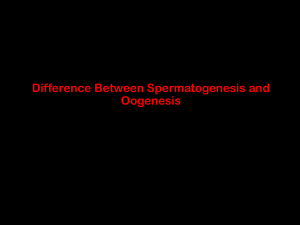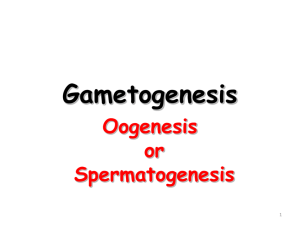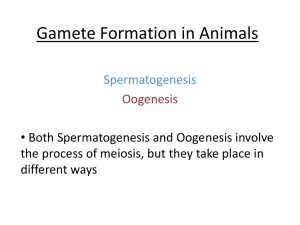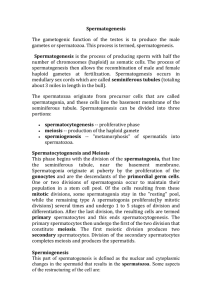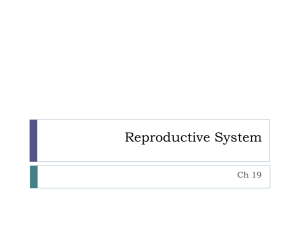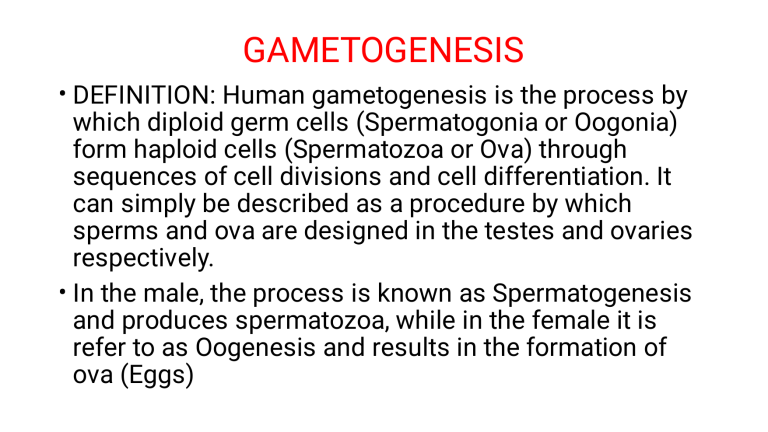
GAMETOGENESIS • DEFINITION: Human gametogenesis is the process by which diploid germ cells (Spermatogonia or Oogonia) form haploid cells (Spermatozoa or Ova) through sequences of cell divisions and cell differentiation. It can simply be described as a procedure by which sperms and ova are designed in the testes and ovaries respectively. • In the male, the process is known as Spermatogenesis and produces spermatozoa, while in the female it is refer to as Oogenesis and results in the formation of ova (Eggs) SPERMATOGENESIS • Spermatogenesis is the process by which spermatogonia are transformed into mature spermatozoa • Spermatogenesis takes place in the seminiferous tubules. The germinal tubules are lined with germinal epithelium which largely comprises of primordial germ cells and supporting cells (Sertoli cells) • Males start producing sperms when they attain puberty. Sperms are produced in large quantity (100 to 200 million per day) to maximise the possibility of sperm reaching the liberated egg • Sperms are produced continually, because males need to utilize the small fertility window of the female Spermatogenesis continue • Spermatogenesis has three sequential phases: 1. Mitotic proliferation phase 2. Meiotic division phase 3. Cytodifferentiation phase • Mitotic proliferation phase: is a phase that produces large number of cells through mitotic divisions. • Just before puberty, the sex cords of the testes acquire lumen and becomes seminiferous tubules and concurrently, primordial germ cells give rise to spermatogonial stem cells (SSCs) which form a pool Diagram showing spermatogenesis (Adapted from online biology) Mitotic proliferation phase continue • At successive interval, the SSC pool releases some cells to form Spermatogonia Type A and their production marks the beginning of spermatogenesis • Each of these type A spermatogonia undergoes a number of mitotic divisions to produce a clone of 16 cells • Each of the cells in the clone undergoes a further several mitotic divisions to form type B spermatogonia • The number of mitotic divisions from SSC to type B spermatogonia determines the total number of cells in the clone. Their number is however reduced by apoptosis to a large extent • Each of these Type B spermatogonia then undergoes further mitotic divisions to form Resting Primary spermatocyte which marks the end of proliferation phase Mitotic proliferation phase continue • It is to be noted that all through the mitotic phase of spermatogenesis, nuclear division (Karyokinesis) is complete, but cytoplasmic division (Cytokinesis) is incomplete. Hence the primary spermatocyte derived from one type A spermatogonium are linked together by thin cytoplasmic bridges • This linkage persist even in the meiosis phase and continue till the formation of mature spermatozoa Meiotic division phase • The meiotic division phase is aimed at reducing the chromosome number to half and to create genetic diversity • Prior to entering the prophase 1 of first meiosis, each resting primary spermatocyte duplicates its DNA content • These primary spermatocytes with the duplicated DNA then enter the prophase 1 of first meiosis which is very prolonged and lasted for about 22 days as it passes through its different stages (leptotene, zygotene, pachytene, diplotene and diakinesis) • During the pachytene stage of prophase 1, the sister chromatid strands on the paired homologous chromosomes come together to form synaptonemal contacts during which the chromatids break, exchanged segments of genetic materials and then rejoin, thereby shuffling the genetic information before separating themselves Meiotic division phase continue • The first meiotic division ends with the separation of homologous chromosomes to the opposite pole of the cell on the meiotic spindle, followed by cytokinesis which results in the formation of two secondary spermatocytes • The secondary spermatocytes contain a single set of chromosomes consisting of two chromatids joined at the centromere. • The secondary spermatocytes are short-lived as they quickly enter into the second meiosis during, which the chromatids separate and move to opposite pole of the second meiotic spindle • This is followed by formation of nuclear membrane and cytokinesis yielding haploid round spermatids CYTODIFFERENTIATION PHASE • The Cytodifferentiation phase involves the remodelling or transformation of the round spermatids into mature spermatozoa and is refer to as spermiogenesis • During this process, some major cytoplasmic changes occur. Such changes include the followings: I. The spermatids change shape from round to elongated II. Tail for forward propulsion is formed III. Mid-piece containing mitochondria is formed. The mitochondria generate energy for the cell. IV. Condensation of the nucleus takes place V. Formation of Acrosome that occupy about half of the head of the sperm from the Golgi apparatus. The acrosome contains enzyme that aid penetration of the ova and its surrounding layers during fertilization VI. Shedding of most of the cytoplasm Cytodifferentiation phase continue • The end result of spermiogenesis is the formation of mature spermatozoa • With appearance of the spermatozoa, the thin cytoplasmic bridges rupture and the sperm cells are released into the lumen of the tubules in a process called spermiation and are washed along the tubules with the testicular fluid secreted by the Sertoli cells • From the seminiferous tubules, the spermatozoa enter the epididymis during which they become fully motile Diagram showing the structure of sperm (Adapted from Boundless biology) Spermatogenic cycle • There are about 30 seminiferous tubules per testis in human. In each of them certain number of spermatogonia emerge from the SSC pool to commence spermatogenesis • Once spermatogenesis commences in a tubule from SSC pool, new spermatogonia cannot emerge to generate a new clone until several days elapsed • The period of occurrence of successive spermatogenesis is said to be constant and species specific. It is 16 days for human and 12 days for rat • This cyclical initiation of spermatogenesis is what is refer to as spermatogenic cycle OOGENESIS • Oogenesis is the process of transformation of oogonia to a mature ova. • It begins during foetal life. When the primordial germ cells arrived in the ovary, they are differentiated into Oogonia which undergo mitotic divisions and are arranged in clusters surrounded by follicular cells • Similar to spermatogenesis, Oogenesis also passes through three processes – Mitotic proliferation, meiosis division for genetic reshuffling and chromosomal reduction and cytodifferentiation • Unlike in the male, mitotic proliferation in the female is slight, hence only limited number of oogonia are produced as only one or few oocytes are released during each cycle • The oogonia then undergo several mitotic divisions and by 20 weeks of development yielded the maximum estimated number of 7 million Diagram showing Oogenesis process (Adapted from online biology) Oogenesis continue • However, due to apoptosis, the number of oogonia is reduced to 2 million. At birth the total number of oogonia left in the ovary is between 700,000 to 2 million • By beginning of puberty only 400,000 oogonia remain in the ovary as greater number of them became atretic during childhood • Of the 400,000, only about 400 – 500 will be ovulated • Most of the oogonia continue to divide by mitosis, but few went into prophase I of first meiosis and arrest at the diplotene stage to form primary oocytes • Just before birth, all the primary oocytes have entered into meiosis I, with most arrested at diplotene instead of proceeding to metaphase. Also, most of them are individually surrounded by flat epithelial cells (follicular cells) to form primordial follicle • The primary oocyte remain in prophase and do not complete their first meiosis before puberty Meiosis division phase of oogenesis • At puberty pool of growing follicle is established and replenished regularly from the primordial follicles • Every month, about 15 to 20 follicles are selected from the pool to undergo maturation as they pass through different stages – primary or preantral, secondary or antral (Graafian) and preovulatory or tertiary follicle • The preantral stage is the longest while the preovulatory stage is the shortest and last for 37 hours before ovulation • The growth from primordial follicle to preantral follicle is characterised by initial increase in its diameter from 20 µm to between 200µm and 400µm. • During this period, the oocyte within also increases in size to its final diameter of 60 - 120µm as the surrounding follicular cells change from flat to cuboidal and proliferate to form a stratified epithelium of granulosa cells. The whole unit is now known as primary follicle Meiosis division phase of oogenesis • The granulosa cells that surround the primary oocyte lie on a basement membrane that separate the oocyte from the surrounding stromal cells known as theca folliculi • As the follicle continue to grow, the granulosa cells and the oocyte secrete glycoprotein know as zona pellucida that envelops the oocyte. Also, the theca folliculi is differentiated into inner layer of secretory cells known as theca interna and an outer fibrous layer known as theca externa • The development of these two thecal layers marks the end of the preantral follicular stage Transition from preantral to antral follicle • As the follicle continues to grow, the granulosa cells also proliferate resulting in further increase in size • In between the granulosa cells, a viscous fluid begins to appear and later these drops of fluids coalesce to form a single follicular fluid space called Antrum and this marks the beginning of the antral or secondary follicular phase of development • The follicular antrum then divides the granulosa cells into an inner group that surround the oocyte known as Cumulus oophorus and a peripheral group known as Mural granulosa cells • Increase in follicular size now depends on an increase in size of the follicular antrum and at maturity its size is about 25mm or more in diameter • The fully matured antral follicle is now ready to enter the preovulatory phase whose commencement is induced by the LH surge. It last for only about 37 hours before being ovulated. This marks the end of meiosis I, leading to the formation of two unequal daughter cells – the secondary oocyte that receives most of the cytoplasm and the first polar body with virtually none Diagram showing Antral follicle (Adapted from online biology) Oogenesis continue • The secondary oocyte then enters meiosis 11 and get arrested in metaphase stage about 3 hours before ovulation • Meiosis two is completed only if fertilization occurs. If the oocyte is not fertilized, it degenerates about 24 hours after ovulation CLINICAL IMPLICATION • During spermatogenesis, a number of abnormal spermatozoa are frequently observed. • They include abnormalities of the head: 1. Globozoospermia – most of the sperm cells have small round heads, without acrosome. Such men are usually infertile 2. Double head – one mid-piece and tail, but with two heads 3. Tapered head – head is cylindrical and tapers at the apex 4. Amorphous heads – the head is without a specific shape 5. Pyriform head – head appears triangular in shape with the apex wide and a narrow region attached to the mid-piece 6. Vacuolated head – head has many vacuoles Abnormalities in spermatogenesis • Neck and midpiece defects: 1. Bent neck 2. Asymmetrical insertion of the neck/ midpiece 3. Thick and thin insertion • Tail defects: 1. Coiled tail 2. Short tail and 3. Bent tail • Excess residual cytoplasm Pictorial representation of sperm defects ( Adapted from WHO laboratory manual) Abnormalities of oogenesis • Compared to spermatogenesis, in the human fewer abnormalities are observed during Oogenesis. • Occasionally, one ovarian follicle may contain two or three oocytes. Such follicles usually degenerate before reaching maturity. In rare cases, twins or triplets could result from such follicles • There are also some situations where one primary oocyte may contain two or three nuclei (Binucleated or trinucleated oocytes). They however, die off before amturity

